AI-Powered Toys Invade US Shelves, Following China's AI Toy Revolution


Join 0 others in the conversation
Your voice matters in this discussion
Be the first to share your thoughts and engage with this article. Your perspective matters!
Discover articles from our community

 Hoppi
Hoppi

 Hoppi
Hoppi

 Hoppi
Hoppi

 Hoppi
Hoppi

 Hoppi
Hoppi
 Hoppi
Hoppi

Breaking News: Brazil's Supreme Court Convicts Ex-President Bolsonaro of Coup Attempt Brazil's Supreme Court has reached a majority vote to …

Hoppi

Fortnite Ditches 'Peacemaker' Emote After Show's Big Reveal Epic Games made the unexpected move to disable the "Peacemaker Hips" emote …

Hoppi

URGENT: Mother of Hostage Tamir Nimrodi Pleads for Trump's Intervention as Fate Remains Unknown The mother of Israeli hostage Tamir …

Hoppi

Princeton's AI Reveals What Fusion Sensors Can't See A groundbreaking new tool developed by Princeton University researchers is revolutionizing the …

Hoppi

Elon Musk Buys $1 Billion Worth of Tesla Shares In a move seen as a vote of confidence in the …

Hoppi
Future Fatigue: Experts Warn of Lacking Vision for Tomorrow In a stark departure from the futuristic ideals of the 20th …

Hoppi